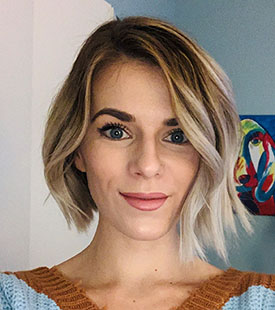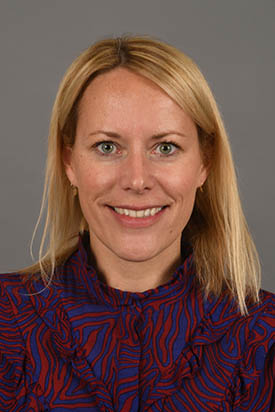Highlighting NIH’s Outstanding Women Fellows
10th Annual Women Scientists Advisors Scholars Symposium
Ever since 2011, the outstanding research achievements of NIH women postdocs have been recognized at the Annual Women Scientists Advisors (WSA) Scholars Symposium. On October 5, 2020, postdoctoral fellows Alix Warburton (NIAID) and Ida Fredriksson (NIDA) presented their work. They had been selected as WSA scholars from among the 95 women recipients of the 2020 Fellows Award for Research Excellence (FARE).
The WSA aims to promote, retain, and recruit women scientists to NIH. “These aims are achieved by providing mentoring opportunities for women scientists, highlighting their achievements with awards and symposiums, encouraging women scientists to participate in training opportunities, and advising NIH leadership and institute directors on achieving equity for women scientists,” said NCI Senior Scientist Mary Kearney, a WSA member and symposium organizer.
When asked about their scientific journey to becoming WSA scholars, both Warburton and Fredriksson emphasized their mentors’ roles and lauded the NIH’s atmosphere for fostering unique international and collaborative opportunities.
Alix Warburton (National Institute of Allergy and Infectious Diseases)
Education: Ph.D. in molecular and clinical pharmacology from the University of Liverpool (Liverpool, England)
Mentor: Alison McBride, Chief of NIAID’s DNA Tumor Virus Section
Talk: “Mechanisms of Tandem Repeat Formation at HPV Integration Sites in Cervical Carcinoma Cells”

Interested in how human papillomavirus (HPV) genomes are integrated into cellular chromatin in HPV-associated cancers, Warburton investigates the role and mechanism of the HPV integration locus in oncogenic progression. She studies the clonal selection of integration events that sustain oncogene expression and the role of hijacking cellular enhancers at HPV-integration loci in cervical cancer, with emphasis on alterations in common fragile sites (large regions of genomic instability). In cervical cells, she showed that integrated HPV16 could result in the formation of a super-enhancer-like element that drives transcription of the viral oncogenes (PLoS Genet 14:e1007179, 2018).
When asked about unexpected findings in her research, Warburton commented on how “interesting it is that each integration locus is fundamentally unique, which has different implications for cancer progression, and the translational potential of applying basic mechanistic understandings to other human viruses.” She mentioned a need for further study of the effects of silencing tumor suppressors or amplifying oncogenes, particularly those that promote cancer progression.
Ida Fredriksson (National Institute on Drug Abuse)
Education: Pharm.D. from Uppsala University (Uppsala, Sweden); Ph.D. in neuroscience from the Karolinska Institute (Solna, Sweden)
Mentor: Yavin Shaham, Chief of NIDA’s Behavioral Neuroscience Research Branch and of the Neurobiology of Relapse Section
Talk: “Incubation of Oxycodone Craving After Conflict-induced Voluntary Abstinence”

To better understand the clinical problem of high relapse rates during abstinence from addictive drugs, Fredriksson decided to study rats to determine the mechanisms of incubation (the time-dependent increases in drug-seeking behavior) of oxycodone craving during abstinence. After a period of drug self-administration, rats experienced an increase in their drug-seeking behavior during a forced drug abstinence period in the home cage (the classical incubation of drug-craving model). However, this model does not mimic the human condition in which abstinence is self-imposed despite drug availability, and relapse may involve conflict (arguments with other people).
Fredriksson’s solution was to use an electric barrier model to imitate voluntary abstinence, which involves introducing adverse consequences (such as punishment) of continued drug self-administration. The most unexpected finding from her research was that the electric-barrier-induced abstinence increased, rather than decreased, oxycodone craving and seeking behavior, suggesting that abstinence induced by negative consequences (discipline, punishment, incarceration) in humans might paradoxically increase relapse vulnerability (Neuropsychopharmacology 44:465–477, 2019).
Fredriksson’s current projects include using whole-brain imaging to identify neural projections in the rat brain that are activated during relapse; and functional magnetic-resonance imaging to monitor neural-circuit mechanisms.
The NIH WSA Scholars Symposium was sponsored by WSA and the NIH Office of Research on Women’s Health. The WSA committee, formed in 1993 under then–NIH Director Bernadine Healy, aims to advance the scientific careers and scientific contributions of women at NIH. Each year, the WSA selects two or three awardees from the pool of female FARE winners for this special recognition and gives them the opportunity to present their research to the NIH community. To learn more about the history and activities of the WSA, visit https://sigs.nih.gov/wsa.

Frances Fernando has been a postbaccalaureate fellow in the Division of Intramural Population Health Research (Eunice Kennedy Shriver National Institute of Child Health and Human Development) since 2019. After completing her NIH training in 2021, she plans to pursue a doctorate in public health to work on integrative global health issues and human rights. Outside of work, she gardens and explores Washington D.C. by bike.
This page was last updated on Monday, March 21, 2022
